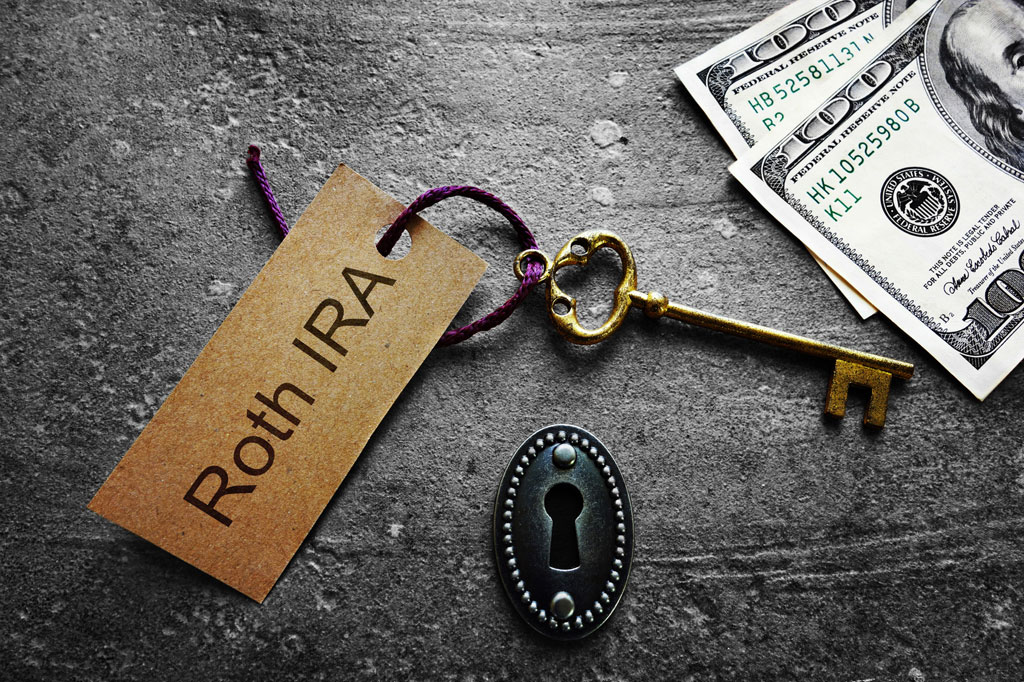“Mega Backdoor Roth” – The Definitive Guide
Vladimir Kouznetsov, EA, CFP®
December 12, 2018
Tax Implications and Benefits of the Mega Backdoor Roth

What is “Mega Backdoor Roth IRA”? It is a financial planning technique that deals with contributing funds to a Roth IRA retirement savings account.
Why does my Roth IRA need a “backdoor”? Your direct contributions to Roth IRA may be limited. There are two different limitations. The first limitation deals with the amount of money you can contribute to the account. In 2018 the maximum contribution amount is $5,500 per person for both IRA and Roth IRA combined for the year. A person over age 50 can make an additional $1,000 catch-up contribution a year. The base limit goes up to $6,000 in 2019 with “catch-up” contribution limit staying at $1,000.
There are also income limits for Roth IRA contributions. In 2018 for a single person, the ability to contribute to Roth IRA becomes limited with income over $120,000. Contributions are completely phased out with income over $135,000. In 2019 these limits go up by $2,000 to the $122,000 – $137,000 range. For married filing jointly the phase-out range is $189,000 – $199,000 in 2018. The range goes up by $4,000 in 2019 to the $193,000 – $203,000 amounts. Phase-out range for married filing separately is $0 – $10,000.
If your income is over the phase-out limit, you may want to explore some other planning techniques to make the Roth IRA contribution. “Mega Backdoor Roth” is one of those planning techniques. “Mega Backdoor Roth” planning can be especially beneficial if you want to contribute more money than the current year Roth IRA direct contribution limit.
Why is it called “Mega Backdoor Roth”? Are there any other kinds of “backdoors”? First of all, it is not really a “backdoor,” but people call it so. It is a Roth IRA planning technique that deals with Roth IRA contributions. There are several different ways to contribute money to a Roth IRA retirement account. Among them are direct contributions, Roth Conversions, “Backdoor Roth IRA” conversions and rollovers from qualified retirement plans. Qualified retirement plans include 401(k) or Roth 401(k) plans, 403(b) plans and governmental 457(b) plans. As you can see, there is one more planning technique with “Backdoor” in the name.
The “Mega Backdoor Roth” planning technique involves a rollover from 401(k) plan to fund Roth IRA account. In contrast to Roth IRA, there are no income limits for 401(k) retirement plan contributions. You may be able to contribute to your 401(k) retirement plan even when your ability to contribute funds directly to a Roth IRA is limited. Contribution amount limits for 401(k) retirement plans are also higher than for Roth IRA. Using “Mega Backdoor Roth” you can contribute up to several times the normal Roth IRA contribution limit amount. That is the reason people call this technique “Mega Backdoor.”
Is it legal? Yes, it is. This planning technique is based on IRS Notice 2014-541. The notice outlines the rules for allocating pre-tax and after-tax rollovers from qualified retirement plans. The IRS rules described in the notice specifically allow after-tax amounts from a qualified retirement plan to be rolled over to a Roth IRA account. That provides the steps necessary to fund Roth IRA account through contributions to a qualified retirement plan account.
Why would I want to contribute money to a Roth IRA in the first place? There are several benefits in using Roth IRA for retirement savings. With Roth IRA you contribute after-tax money into the retirement account. You do not receive an immediate deduction on your tax return. Unlike savings in a taxable account, the funds grow in Roth IRA account generally tax-deferred. That allows money to compound faster, provided they are invested wisely. Most importantly, you do not pay taxes when you receive a qualified distribution from the account.
How does it compare with other retirement accounts, like Traditional IRA or SEP-IRA? In a Traditional IRA or SEP-IRA, you may receive an immediate deduction when you contribute the money. That deduction lowers your overall taxable income that year. That reduces your taxes at your marginal rate – the highest tax rate you pay during the year. A sizeable contribution may even reduce your marginal tax rate and move you into a lower tax bracket. That is an excellent benefit of contributing to a pretax retirement saving account. However, all distributions from these accounts will tax as on ordinary income. You may also pay 10% early distribution penalty if you take money out before reaching 59 ½ if you do not qualify for any other exceptions.
Another critical distinction will come once you reach age 70 ½. At that age, you need to start taking money out of Traditional IRA or SEP-IRA. This is called Required Minimum Distributions. If you fail to do so, the penalty is 50% of the amount. These distributions may increase your overall taxable income and may trigger additional taxes on investment income or Social Security payments. Roth IRA does not have required minimum distributions at this point.
When is Roth IRA better than Traditional IRA or SEP-IRA? Ultimately it comes to deciding if your tax rate in retirement will be higher than your current tax rate. The logic is simple. If your current tax rate is higher than you would benefit more from contributing to a pretax retirement account. In this case, you take a deduction for the amount of contribution at your current higher tax rate. When you retire, and your tax rate is lower, you will be withdrawing the money at a lower tax rate. This may very well be true if you are currently a high-income earner paying taxes at a higher tax bracket.
That logic has one problem. We do not really know what the future holds for us. This is also true for our future tax rates. You may build a successful business and continue to receive a high income all the way through retirement. The tax rates may go up. We currently live in an era of enormous government debt and budget deficit. Sooner or later this situation will need to be resolved one way or another. Many experts believe taxes may go up in the future. You may end up having lower deductions in the future. You, or your loved one, may face “widow penalty.” “Widow penalty” is a situation where surviving spouse will start to file a tax return as single. Single filer tax rates are higher than for “married filing jointly.”
Long story short, we do not know what our future taxes are going to look like. Using Roth IRA, which provides tax-free income at retirement, may insulate you from unpleasant surprises in the future.
It may be beneficial to combine both Traditional IRA with Roth IRA accounts for retirement savings. Our tax system is progressive, meaning part of your income is always taxed at a lower rate. The rate goes up as you are starting to make more money, but only for the new additional funds. Combining both pre-tax and tax-free distributions at retirement would mean that only a portion of your income is taxed. The taxed part may be small enough to stay at a relatively low tax bracket or even within your allowed deduction amount.
How does “Mega Backdoor Roth“ works? The tax code allows several ways to fund Roth IRA account. Each of them has its limits and restrictions. Depending on your particular situation one method may be better for you than another.
Direct Roth Contributions. To make direct Roth IRA contributions, you need to have earned income. If all your income comes from capital gains or passive rental income, you cannot make direct Traditional IRA or Roth IRA contributions. Your spouse earned income can count as well. If you are married and only one of you brings home earned income, both of you can contribute into your own Roth IRA accounts. The amount of contribution is limited to $5,500 per person in 2018. The limit is reviewed from time to time for inflation, in 2019 it is going up to $6,000. Those 50 and over can make an additional $1,000 catch-up contribution. The amount is the same for both 2018 and 2019 years.
Direct contributions may be limited if your incomes are over a certain limit. In 2018 for a single person, the ability to contribute to Roth IRA becomes limited with income over $120,000. Contributions are completely phased out with income over $135,000. In 2019 these limits go up by $2,000 to $122,000 – $137,000 range. For married filing jointly the phase-out range is $189,000 – $199,000 in 2018. The range goes up by $4,000 in 2019 to the $193,000 – $203,000 amount. Phase-out range “married filing separately” is $0 – $10,000.
Roth Conversion. Since 2010 there are no income or dollar amount limits on performing Roth Conversion. In the Roth Conversion, you move money you already have in your Traditional IRA account into Roth IRA. You pay income taxes on the amount of any pre-tax money you are converting in the year you do it. As a result, the government is getting much-needed cash, and you are getting your Roth IRA funded.
“Backdoor Roth IRA” is a planning technique that uses Roth Conversion as a way to get funds into your Roth IRA. In this case, you make an after-tax contribution to your Traditional IRA and then convert the amount into Roth IRA. If you participate in your company 401(k) and have income over a certain limit, your ability make a deductible contribution may be limited. Greta, you are trying to take the deduction anyway. Converting after-tax money from Traditional IRA to a Roth IRA does not have any additional tax consequences in the year of conversion. This technique works best when you do not have any other Traditional IRA account as pro-rata rule still applies. Read more about this technique in “4 Things to Know About Backdoor Roth IRA Conversions.”
Rollover from a qualified retirement plan. Roth IRA can also be funded by rollovers from qualified retirement plans, like 401(k)s. Specifically, you can rollover funds in a designated Roth 401(k) plan account directly into Roth IRA. You can also rollover after-tax contributions from regular 401(k) into Roth IRA as part of the overall 401(k) rollover.
Finally, “Mega Backdoor Roth.” This planning technique uses rollover of after-tax contribution into a regular 401(k) plan to fund your Roth IRA account.
Can I use it? Sure, as long you have a friendly 401(k) administrator and all the stars align in your favor. Just kidding. There are several requirements to use this planning technique.
It would help if you had enough disposable income to make such a contribution to your retirement accounts
You need to work at a company or an organization that sponsors a qualified retirement plan, like 401(k) or a similar qualified retirement plan.
You need to participate in your employer qualified retirement plan.
Your plan should allow after-tax contributions. Most of them do, but not all of them. Read the Summary Plan Description or check with your plan administrator.
Your plan should allow in-service distributions of the after-tax amounts.
Can you give me step-by-step instructions for “Mega Backdoor Roth”? Here is how you do “Mega Backdoor Roth” contribution to your Roth IRA:
You make after-tax contributions into your qualified retirement plan account. Typically it is done through salary deferrals.
You initiate direct rollover of the funds available for in-service withdrawal. Often, but not always, after-tax contributions are the only funds available for in-service withdrawal. Consult with your plan documents or check with your plan administrator about what funds are available for in-service withdrawals and plan accordingly.
If you have both pre-tax and after-tax money in the plan available for withdrawal than pro-rata rule applies. You cannot request distribution of just after-tax money. Your distribution will consist of both pre-tax and after-tax amounts in the same ratio. The simplest and the most efficient way to deal with it is to move all the funds available for withdrawal at the same time.
It is important to use direct rollover when you are moving funds from a qualified retirement plan to an individual retirement account. In-direct or “60-day rollover” may have unintended tax consequences. Here is a great article on the subject:
You roll over any pre-tax amounts of the distribution, if any, to a Traditional IRA or a similar pre-tax retirement plan. These funds can be converted to a Roth IRA later. You will need to pay tax on the amount of the funds converted.
You roll over the remaining after-tax amounts to a Roth IRA.
How much money can I contribute to Roth IRA this way? The answer depends on other contributions that you are making into your qualified retirement plan at work. There are several different types of contributions that qualified retirement plan takes. There are limits on most types of contributions and an overall limit on all of them. The limits are updated every year to account for inflation.
Pre-tax salary deferral.
These are contributions that go directly from your paycheck to your 401(k) account. These contributions are made on a pre-tax basis, meaning you will get a deduction on your current tax return. These contributions are limited to $18,500 in 2018 with an additional $6,000 catch-up contribution allowed if you are over 50 years old.
Designated Roth salary deferral.
Your qualified retirement plan can have a built-in Roth account, and you may be able to make Roth contributions directly. These are after-tax contributions typically to a separate Roth 401(k) account.
Company contributions. There are several potential contribution types in this category, like company match or company profit sharing contributions. That depends on what your company provides. For our purposes in this article, we will lump them together. All the money contributed to your retirement account are on a pre-tax basis.
After-tax contributions. The last type of contributions is after-tax contributions that go into your regular 401(k) account. These are the contributions that can be rolled over to
There is an overall limit on combined contributions that can go into your qualified retirement plan during the year. In 2018 it is $55,000 with an additional $6,000 catch-up contribution allowed if you are over 50 years old.
How much you would contribute to Roth IRA through after-tax contributions to your qualified retirement plan highly depends on your current situation. It would be best if you looked at your overall financial plan to see what would make sense for you.
Most people who are using this technique are relatively high earners and pay taxes at the higher range of tax rates. They usually may benefit from contributing as much as possible to their qualified retirement plan on a pre-tax basis to reduce current taxes. They also maximize their company benefits by getting the highest match possible match. Then they may decide to add more money on an after-tax basis. They will then use direct rollover of these after-tax contributions to fund their Roth IRA account.
Let’s look at the example. Meet Peter who works as an engineer at a technology firm. Between base pay and bonuses he is making around $250,000. His wife Amy is also a high earner, and together they want to accelerate their retirement savings to retire early. They are projecting they will be in 35% federal and 9.3% state tax rates. Their overall marginal tax rate is 44.3%.
Peter and Amy project that their future tax rates may probably be lower than now. They do not have a crystal ball and do not know what future sessions of the Congress will bring us on the tax front. Still, there are a few things they are counting on.
First, their planning to move to a different state for retirement. They are still deciding between Florida and Washington State. Both states do not have the state income tax. That should provide immediate help to their current tax situation.
Second, their earned income will be much lower once they both retire from their corporate jobs. While Peter can never sit still, he will probably continue to work one way or another. He may start teaching, doing some consulting, or maybe finally find some time to develop that fishing smartphone app he was talking about for years now. In any case, his earned income will probably be much lower than at his current position.
Third, they are diligent at saving some money in their Roth IRA accounts and so that in future they can use it to complement their taxable income. They are used to their current lifestyle and want to continue to maintain a similar lifestyle going forward. That means they will need roughly the same level of disposable income as they have now. When most of the disposable income is coming from taxable sources, the tax rate may be exactly the same. If the tax rates go up, they even may end paying taxes at a higher rate. With tax-free income at retirement from sources like Roth IRA, they will need to draw less money from a taxable source. That can help them to stay in a lower tax bracket.
Peter and Amy discussed their plan with their financial advisor and decided to contribute as much as possible to their pre-tax retirement fund. They also want to save additional money on an after-tax basis to fund Roth IRA. They cannot contribute to the Roth IRA directly based on their overall income being over the income limit. They can benefit from using “Mega Backdoor Roth” while Peter is still working. At retirement, they can continue to fund Roth IRA by performing periodic Roth Conversions. Doing so may help them to reduce their overall lifetime taxes even more.
Peter participates in his company 401(k) plan. He sets his salary withholdings to defer $18,500 of his earnings to his 401(k) on a pre-tax basis. His Company provides a matching contribution in the amount of 50% of the participant contribution up to 6% of the compensation amount. In Peter’s case, the company portion comes to $7,500. Company match goes into his 401(k) plan account on a pre-tax basis as well.
Total pre-tax contribution Peter is getting into his 401(k) plan is $26,000. Peter can contribute another $29,000 to his 401(k) plan on an after-tax basis and use this money to fund his Roth IRA account.
Peter’s company 401(k) plan does not allow in-service withdrawals of pre-tax salary deferrals and company match contributions until Peter reached age 59 ½ or separates from service. Peter hopes to separate from service well before that.
After-tax contributions to Peter’s 401(k) plan, on the other hand, are available for in-service distributions. In his 401(k) plan, these are the only money that can be rolled over from the retirement plan into an individual retirement account.
Peter set’s his salary deferral to contribute an additional $2,165 a month to his 401(k) plan on an after-tax basis. With the help of his financial adviser, Peter opens a Roth IRA account. They get together on the phone once a quarter to initiate direct rollover of the after-tax funds from Peter’s 401(k) retirement plan into his Roth IRA account. Money in his Roth IRA plan invested and generate capital gains that will be available for him after he reaches 59 ½ age on a tax-free basis.
With this plan, Peter and Amy can retire once Peter reaches age 55. While funds in his Roth IRA will not be available for another 4½ years, Peter can start receiving distributions from his 401(k) plan at age 55 without paying any early distribution penalty. There is an exception from typical 59 ½ rules for retirement accounts available to people who retire from a company that provides a qualified retirement plan. The exception is limited to that company plan only and not to individual retirement accounts or qualified retirement plan accounts from previous employers.
Why don’t I just leave my after-tax contributions in 401(k) retirement plan and let it grow there? You can. The money you contribute is after-tax money already. In this way, these contributions are similar to the Roth contributions. The money will also grow tax-deferred, similar to the Roth account. The difference between designated Roth contributions and after-tax contributions into regular 401(k) becomes apparent once you decide to get distributions from the account at retirement.
All the earnings received from Roth IRA as qualified distribution are tax-free. To get the qualified distribution, you need to meet the 5-year account opening rule and 59 ½ age rule. To meet Roth IRA 5-year account opening rule, you need to have at least one Roth IRA account opened and funded for more than five years regardless of your current age. If you open your first Roth IRA account when you are 59 years old, you still need to wait for five years before receiving any earning distributions from the account tax-free. Keep in mind that in Roth 401(k) world this 5-year rule is on a per account basis. That means you have a separate 5-year clock on each of your Roth 401(k) accounts.
Citations
1 – www.irs.gov/pub/irs-drop/n-14-54.pdf
This information has been derived from sources believed to be accurate. Please note - investing involves risk, and past performance is no guarantee of future results. The publisher is not engaged in rendering legal, accounting or other professional services. If assistance is needed, the reader is advised to engage the services of a competent professional. This information should not be construed as investment, tax or legal advice and may not be relied on for the purpose of avoiding any Federal tax penalty. This is neither a solicitation nor recommendation to purchase or sell any investment or insurance product or service, and should not be relied upon as such. All indices are unmanaged and are not illustrative of any particular investment.
Recent updates



Understanding the Ins and Outs of Workplace 401(k) Plans


Similar stories
Latest articles from the "Tax Strategies" category.